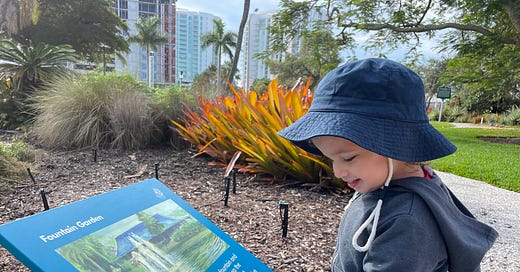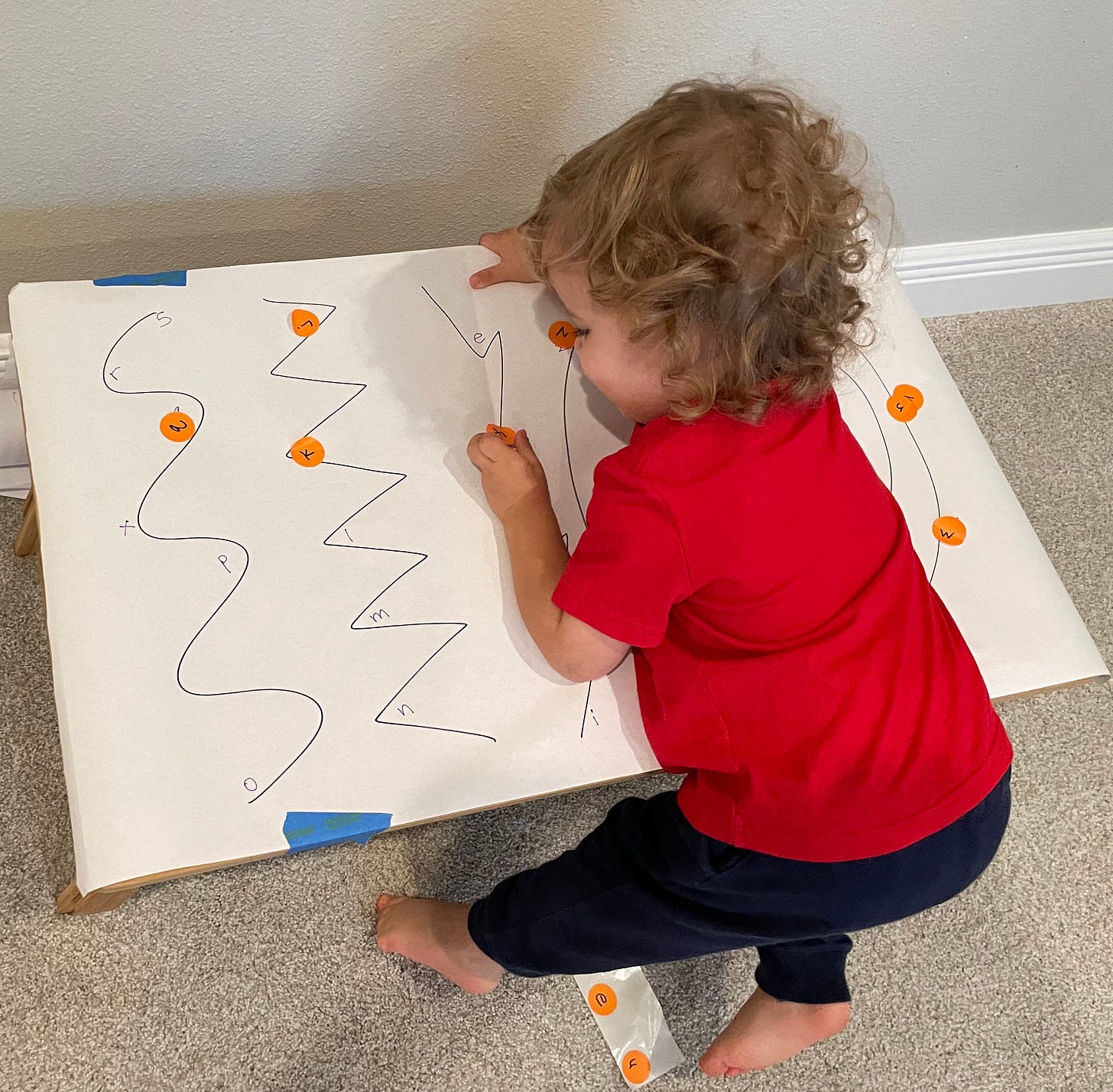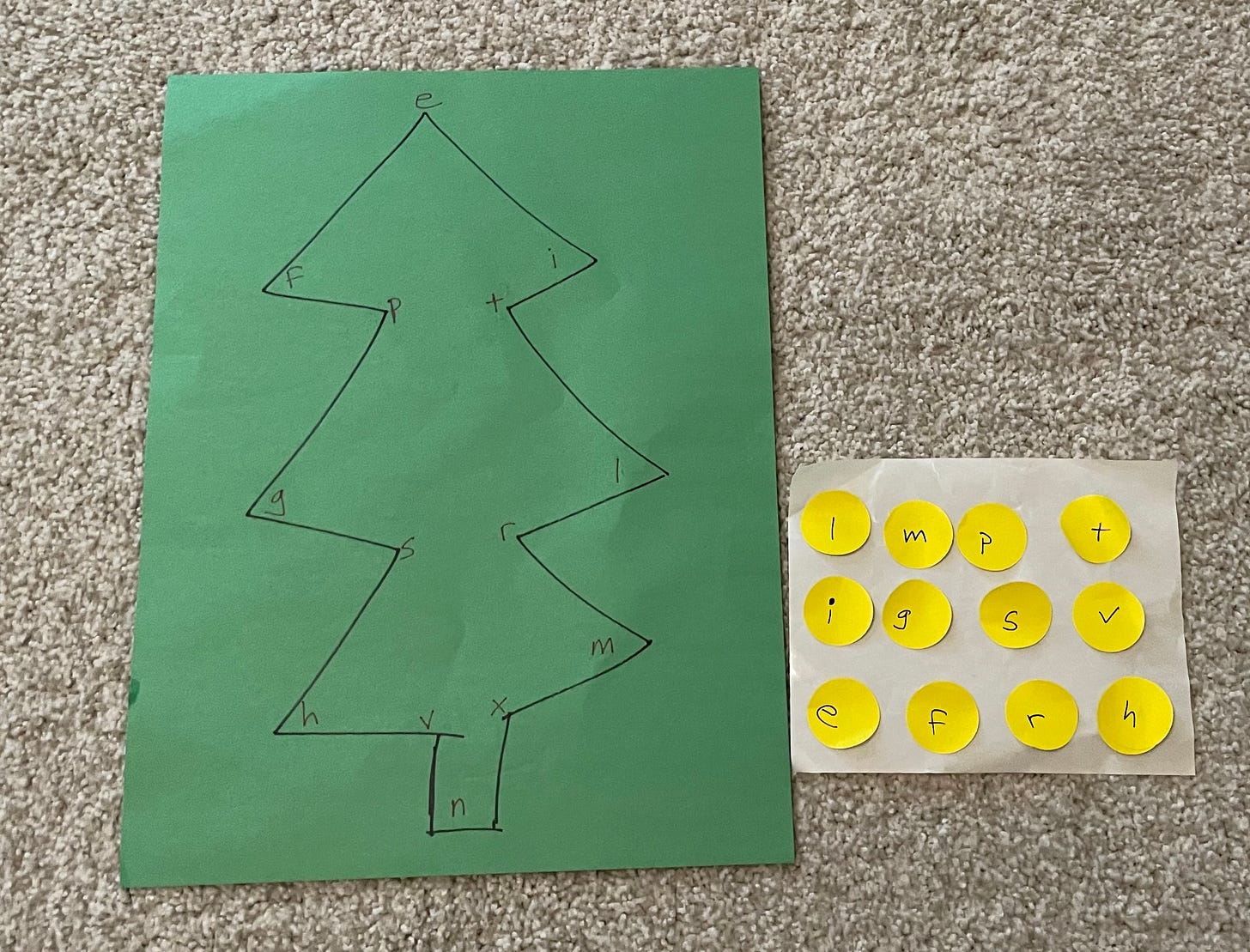How to Teach Letters and Letter Sounds to a 1-Year-Old
Edition 31: Making early literacy fun and educational
Around 18 months, Hayden showed an interest in letters and their sounds. That interest has intensified into a burning passion over the past few months. Simply put, Hayden (who’s now 22 months) is obsessed!
I was surprised by Hayden’s early interest in letters. I was also a bit unsure of this new path we were heading down. I want to give him what he wants and needs. I also want to keep this burning passion alive. After all, learning to read is a key that unlocks everything.
The question is: how do you teach letters and their sounds to a one-year-old while growing their interest?
Over the past few months, I’ve realized that the answer comes in four parts:
Begin with an eager learner
Be prepared
Make learning fun
Show your enthusiasm
I’ve been using this simple recipe for the past few months. Not only has our journey into letters and sounds been a blast. But also Hayden has made significant improvements. He can identify all the letters in the alphabet and says the phonetic sound for most letters (we’re still working on the sounds for some letters, like j, x, and w). Here’s how our process has unfolded.
Begin with an Eager Learner
Hayden is genuinely interested in letters and their sounds; I’m not pushing them on him. And the more he learns, the more he seems to enjoy it. He’s eager to learn more, which isn’t surprising. When you’re intrinsically motivated to learn or do something you just can’t get enough of it.
That’s the key: watching for that intrinsic motivation to appear.
For me, that meant being a careful observer throughout our day. I saw where he was spending time and what struck his curiosity. Once the interest in letters was there, I knew I had to get prepared to accurately introduce them to him.
Be Prepared
Oftentimes when parents and educators set out to teach the alphabet, they teach the names of the letters (think: the “abc” song). I’m focusing on the sound for each letter.
For example, the letter m is pronounced mmm. So this is how I refer to the letter m with Hayden: “mmm like mat or mama.” Or while reading a book, I’ll say: “I’m looking for mmm. Do you see mmm on this page?” And he’ll point to the letter m. Letter names will come later. Right now, they just introduce unnecessary confusion at this early stage.
I’m also focusing on the lowercase alphabet because we encounter many more lowercase letters than uppercase ones while we read.
I only introduced a few letters at a time to keep things manageable. But, and this is an important point, before I introduced a new letter I made sure I could say it correctly myself. I plan to use the book, Teach Your Child to Read in 100 Easy Lessons, once Hayden is ready to read. So I referenced a YouTube video, which supports this book, to ensure I correctly said the sound of each letter correctly.
From there, it’s all about catering to your child’s interests by making learning fun.
Make Learning Letters and Sounds Fun
Hayden is intrinsically motivated to learn the letters and sounds. My role is to help guide the process along. I’m doing that by making learning fun. After all, we’re more motivated to do something that we enjoy, even as adults.
Learning letter sounds is interleaved throughout our day. Below are some of the activities we’ve done over the past few months.
Letter Matching
Hayden went through a long phase of wanting to play the game hide and seek, where I’d hide a bunch of toy cars, bugs, shapes (or anything!), all of the time. He’d find each one object and match it to the respective picture of the car, bug, or shape.
So I took this established interest and combined it with his newfound interest in letters.
I wrote out a few letters on a piece of foam board and hid the letters around his playroom. He found the letters, one at a time, and matched them to the board.
This activity helped him with letter recognition. It also helped him learn the sounds, because I’d say the sound of the letter each time he found one. Eventually, he said the sounds, too.
Items needed:
Foam board (You can use paper, of course. But I found foam board to be much more durable.)
Letters
Letter Sticker Match
This idea came from the website, Busy Toddler, and it worked really well during the very early stage of letter learning. This is another great activity for letter recognition.
It involves another favorite of Hayden’s: stickers. I wrote a letter on a piece of paper and taped it to the wall. I did this for five or six letters. Then, I took some dot stickers and wrote a letter on each sticker.
Hayden would peel off a sticker, I said the letter sound (and he eventually did, too), and he placed it on the correct letter.
Items needed:
Paper
Muffin Tin Letter Drop
I took a muffin tin and put a letter in each space. I cut circles from white paper, wrote a letter on each circle, and taped one circle in each space.
Then, I took wood chips and wrote a letter on each side of the chip. Hayden takes one chip at a time and drops the letter in the matching space. For example, a wood chip with s goes into the space with s in it.
I’d update the muffin tin with new letters as introduced new ones to him, or the ones he struggled with.
This is another great activity for teaching letter recognition. He continues to love this activity.
Items needed:
Muffin tin
Paper
Tape
Drawings with Hidden Letters
The idea behind this activity began when I was researching Christmas art activities for toddlers, and I stumbled upon a website (which I can no longer recall) that featured an activity to create an alphabet tree.
The parent draws a tree on a piece of paper with a bunch of letters on it. Then, they write the corresponding letters on some dot stickers. The aim is for the child to match each dot sticker to the letter on the tree.
I gave it a try, and it was an immediate hit!
So I expanded my rudimentary drawings to include stars, shapes, wavy lines, and swirls. I also expanded the size of these drawings: I now use butcher paper, instead of construction paper.
I sprinkle letters throughout each drawing and write the corresponding letters on dot stickers. Hayden peels off a sticker and says the sound of the letter as he looks for it in the drawing. In fact, part of the fun for him is finding each letter.
This activity has been a long-time favorite for Hayden. I update the drawings regularly to keep it interesting for him. I’ve also added on to this activity.
At first, I’d say a word that began with the letter found on the sticker. For example, if Hayden peeled off a sticker with the letter a on it, I’d say: “ahh like apple.” Now that he knows his letters and sounds, I write a word that begins with that letter. In this case, I’d write the word apple on a piece of paper.
Items needed:
Paper (construction paper, printer paper, or my favorite: butcher paper)
Sharpie
Draw Letters on the Driveway with Chalk and Match Them
This activity hasn’t gotten old yet! It involves a bunch of letters and chalk.
Here’s how it works: I draw letters on the driveway with chalk. Then, Hayden picks up a letter and finds the match.
I’ve done this activity with a few variants to keep things interesting and fun. Sometimes I just have a bag of letters for Hayden to explore, and he picks one letter at a time. Other times I hide them in a container of dirt or sand. Once he finds a letter, he finds the match. Part of the fun is in the search.
There are days when I write letters out on the driveway in random order. There are others when I write simple words. (I’m doing more of the latter now since Hayden knows all of the letters.) Once he matches an entire word, I say it slowly (ie, mmmaaattt) and then quickly (mat). Although he’s not blending sounds yet, I’m trying to set the stage for this future step.
Items needed:
Letters
Chalk
It Starts With ….
Sound games are so simple and a lot of fun. One that we play often goes like this: “goat starts with …” Then, I pause and wait for Hayden to say the sound for the letter g. Or I may say: “table starts with …” Then, I pause and wait for Hayden to say the sound for the letter t.
Sometimes I accompany this game with written words. So I may write the word “goat” or “table.” In fact, when I first tried this game with Hayden, that’s exactly what I did. That way, he understood what I meant by “starts with.” Plus, he can see the sounds he’s learning in action.
Other Activities to Try
Hayden has a letter puzzle, which he adores. He also enjoys using letters with playdough—especially when I “hide” the letters in the dough. I’ll even bring some letters with us when we go to a park. He loves to line them up on the park bench, and, of course, say each sound as he goes along.
And, of course, there’s reading. Now while reading books Hayden likes to point to the letters and say their sounds. In addition to books, there are things to read throughout the day, such as the label on the jar of almond butter or the box of pasta.
In my experience, showing your child that words are everywhere just heightens the desire and motivation to want to be able to read them. With this increased awareness, Hayden seeks out words on his own. I was stunned the first time he ran up to a sign at a garden and began pointing to each letter and saying its sound (pictured at the top of this newsletter).
Show Your Enthusiasm
Building this foundation is hard work for a young reader. Inevitably a lot of repetition is involved. So keep your energy going through the process.
Energy is contagious, be it positive or negative. Your child can sense if you’re genuinely excited about their efforts reading letters on a sign at the park, for example. Besides, any subject can come alive with the right teacher. A good attitude and some enthusiasm can go a long way. It’s that simple and that hard.
Hayden is still in the very early stages of being able to read, and there are many more steps ahead. In fact, I plan to write a follow-up newsletter in a few months to share the next steps in his learning to read journey.
However, as I reflect on the past few months, two things that stand out. First, he’s made a lot of progress. Second, we’re having a lot of fun. And that’s what learning should be: fun.
“The goal of early childhood education should be to activate the child’s own natural desire to learn.”
-Maria Montessori
Thank you for reading! I’d love to hear from you. Feel free to reply to this email and let me know what you think.
-Amy









